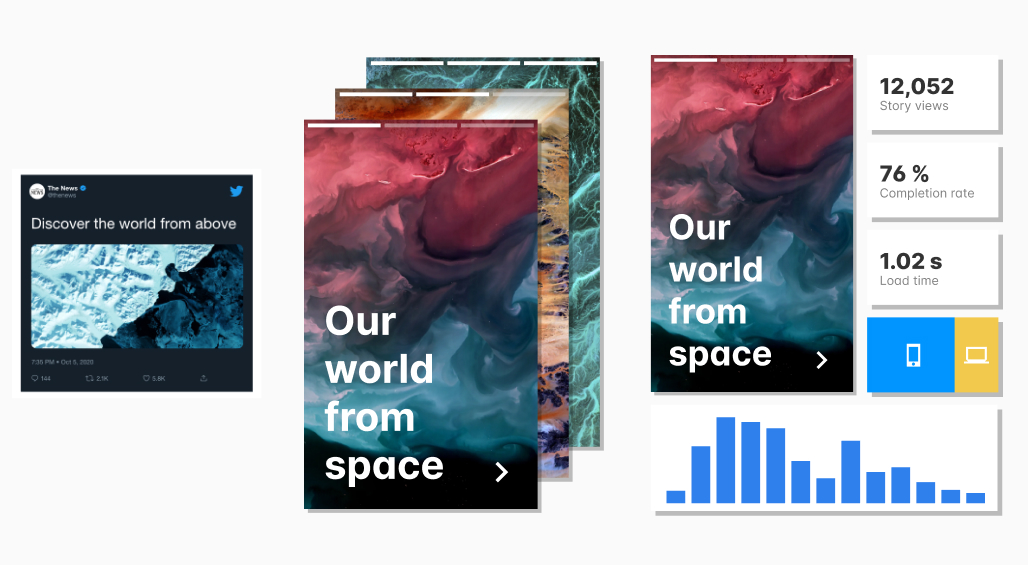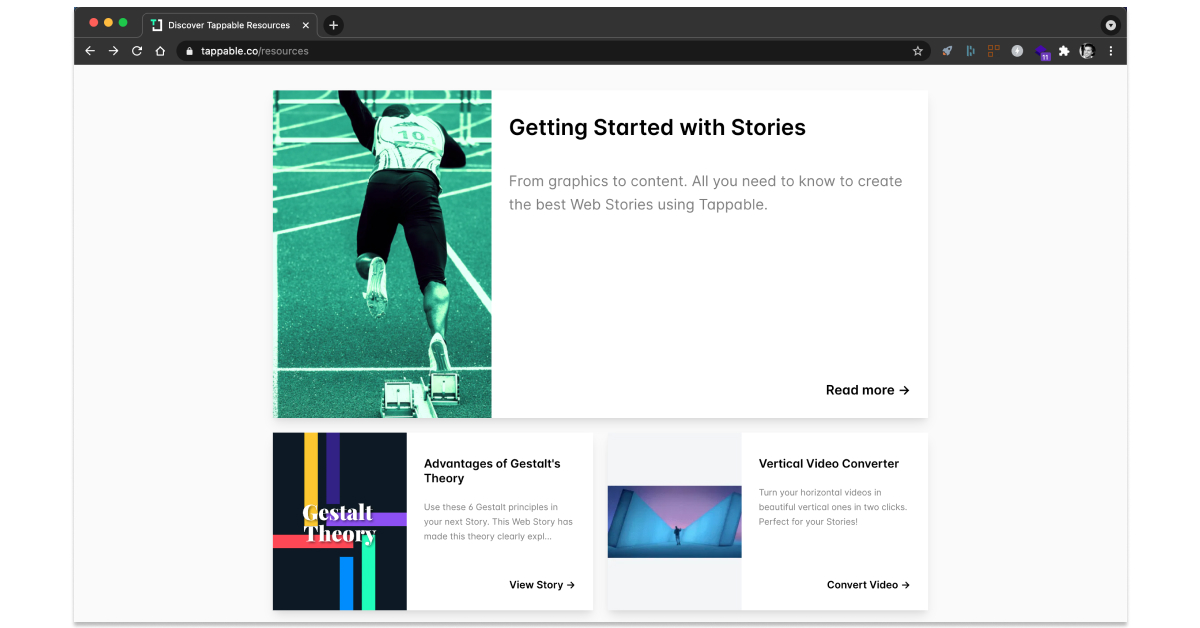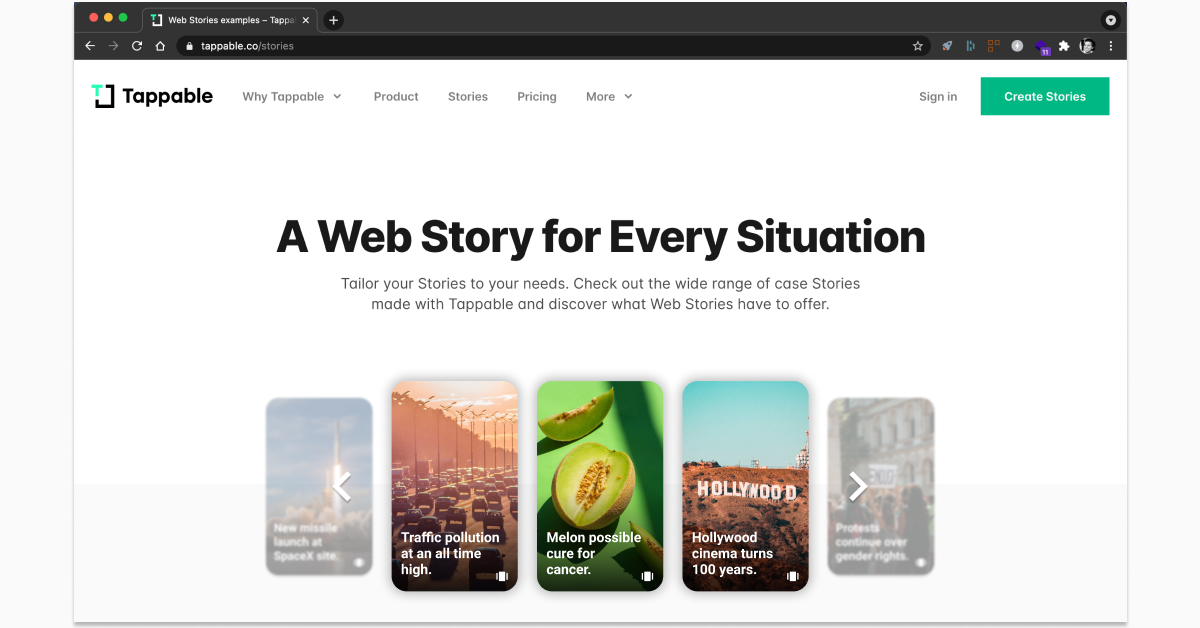Web Stories implementation Playbook
The easiest way to get started with Tappable Stories. From beginners lever all the way to expert level.

TL;DR
This guide helps you introduce Web Stories quickly, easily and cheaply. It is based on our experience with getting teams started. We describe the step by step process of validating the Web Story format and Tappable as a tool. We'll take you through a series of internal testing experiments and getting stakeholder buy-in. We explain how to scale-up and measure your audiences' interest. And collect specific and measurable data at every step along the way. Follow this process to write and present that killer Web Story pitch to your senior management team.
Introduction
Adopting a new format and technology is very much like developing a new skill. Say you want to develop your cooking skills but you've never done anything beyond boiling eggs. What do you do? You don't start by buying expensive professional equipment, right? You work with the equipment you have at hand and you evolve progressively into maybe becoming a Michelin Starred Chef one day. And that's exactly how you're going to proceed with Web Stories!
You're here, so you see the potential and the value of Web Stories. But will your audience like Web Stories? And how do you align your team and company behind Stories? After all, you have absolutely no guarantee that the work you put into integrating Tappable will be met with concrete results further down the line.
This playbook will help you try the format with as little investment as possible and using what you already have. We've broken down the Story creation and distribution process into small reachable milestones. Your goal is to test the format before you make any major commitment.
Now, are you ready to start cooking?

Step 1: Testing a MVS (Minimal Viable Story)
It's only natural to test new formats and products progressively. You only engage in their adoption once they have proven to be popular amongst your internal stakeholders and audiences. And at this stage you don't want to spend too much time testing and prototyping, right?
Tappable's First Story Creation service helps you to test the waters without putting pressure on the workload of your own team. Or you can follow this first step that is meant to help you test the format using existing content while mobilizing very little resources. We're basically going to open your fridge, pick a couple of ingredients you already have and try to prepare something that won't make your kids order takeout...
Editorial Stories
We recommend creating your first Editorial Story as a collection of breaking news headlines. This can be completed under an hour and could look something like this. View Story
Marketing Stories
We recommend creating your first Marketing Story as a collection of products or services. This can be completed under an hour and could look something like this. View Story
1.1 Follow these easy steps
- Team up with a designer to design the first few pages of your first story in order to meet your brand guidelines.
- Select the content you'd like to re-purpose and fill in your Web Story with text and visuals.
- Add a poll at the end of your Web Story to collect additional performance data and measure what percentage of users would like to see more content in this format.
- Publish and use your Social Media pages with your pre-established audience to distribute your Web Story: Create a post on Facebook, LinkedIn, a tweet on Twitter or a swipe-up on Instagram.
You've noticed positive reactions and got enthusiastic feedback on your first Web Story? Check out Step 2 to validate your observation and measure the impact of the format on a wider scope.
We're here to help you create that first Story.

Step 2: Testing Web Stories Effortlessly
Your audience likes Web Stories and they're asking for more but you're not sure if it's really just a ephemeral hype or if the trend is real. You can continue testing the format on your Social Media. This time, you can go one step further by adding a few variables a monitoring the results. And you can still do it all this without soliciting your tech team!
Team recommendations
Team up with a designer to create a template that you can re-use for multiple Stories.
Content recommendation
Use your existing content (your daily headlines, most recent article, week-end digest...).
Distribution recommendation
Use your Social Media accounts to test the format with your pre-established audience.
Follow the guided process in Step 2 for a detailed testing procedure. The resources at hand are all that you need for this step, only with more precision for more measurable results this time. You have all the ingredients to prepare your afternoon a cake, just make sure to use the scale!
2.1 Shortcuts to Web Story distribution and creation
- Distribute through Twitter: Test your Web Stories on existing platforms where you already have an engaged and interactive audience like Twitter. Post your Web Story's link and let your followers react, comment, and retweet.
- Distribute through Social Media: Another reliable outlet to test your Web Stories are your Social Media pages. Drive your audience to your Web Story through a simple post on Facebook/Linkedin or through a Story Swipe-up on Instagram. This way, your Story becomes a landing page for your post, often outperforming any other landing page format.
- Outbound communication: distributing your Stories through SMS, WhatsApp or Telegram groups, Facebook Messenger works incredibly well as the majority of users are already online from their mobile devices. Put them in your emails or newsletters and don't forget the QR code to enhance offline-to-online experiences.
2.2 Analyze Reactions
- Evaluate reception of your first iteration: Check your Web Stories analytics to see how your users are navigating through the format. You can also add a poll at the end of your Web Story to collect additional performance data and measure what percentage of users like to see more content in this format.
2.3 Scale tests
- Test different types of content: Your first Web Story gathered the weekly headlines? Try a new one about a specific article, or maybe with advertorial content.
- Test the time and the frequency: Try to publish your Web Stories at different times and play with their frequency.
- Test the teams in your organisation: Web Stories can be used in multiple departments and for different reasons. Include your teams in the testing phase and see how they make use of the tool and what they think about the format.
- Simplify the creation process: Your designer is busy with other projects? No problem! Opt for the Tappable Design Pack with tailor-made and brand compliant templates. Reduce your input to filling in your most recent content to scale your tests.
2.4 Evaluate the results
- What, how, who, when and where (on Social Media): The more settings you test, the more accurate information you will collect about Web Stories. Compare your collected data, highlight the patterns and determine the parameters that helped your Web Story perform best.
Most organisations go through the second step in about a month. Very often it is just the initiator who handles this phase, or a very small team. The results are audience based, specific and measurable. They are ready to be presented to the management team. Laying the groundwork this way generates stakeholder buy-in and a solid implementation of Tappable inside your organisation.
Now that you've tested the format with accessible resources, you probably want to take your Web Stories' game up a notch. Let's try to distribute your Web Stories through your own platforms and channels!
We're here to create your custom templates.

Step 3: Testing Web Stories on your Platform
You've tried Web Stories through your Social Media or your own outbound channels. You saw positive signs of reception from your audience and you'd like to take your trial one step further? Rest assured, you don't need to call in your developers yet. All you need is access to your Website.
Team recommendation
This is where you get your web manager involved for links and embeds on your platforms.
Content recommendation
Use any existing content you want to reformat or start from scratch.
Distribution recommendation
Use your Website or app to test the format with your own traffic.
Step 3 will allow you to test the format further with your own platform users. We're basically going to pair the meal you just cooked earlier with a wine from that wine boutique a couple of blocks away.
3.1. Control distribution with minimal intervention
- Distribute through your own platform: Test the format using your own traffic through a link or an embedded frame into your homepage or any other page on your website. (no coding is required).
- Simplify the creation process: Your designer is still busy? Work with our Design Pack for a set of templates that you only need to fill with your content. We can even go further and reduce your involvement to zero by creating and managing of your entire Story library through our Creative Services. The possibilities are really endless!
3.2. Analyze Reactions
- Evaluate reception of Web Stories on your platform: Check your Web Stories analytics to see how your users are navigating through the format. You can also add a poll at the end of your Web Story to collect data and analyze reception of the format throughout your audience.
3.3. Scale test
- Test different types of content: Try different categories of content to measure the difference of reception for each (headlines, specific article, advertorial content...).
- Test the location: Try Web Stories in different places on your Website: homepage, landing page, specific articles...
- Test the time and the frequency: Try to publish your Web Stories at a different times and play with their frequency.
- Test the teams in your organization: Test the tool with a different department to get a broader perspective on the format. We can also help you organize a Training session to get any department you want up and running with Web Stories.
3.4. Evaluate the results
- What, how, who, when and where: Confront all the data you got from your second testing phase and see which combination of elements worked best on your platform. From type of content, location, frequency and design, each and every element can give you valuable insights on your audience's reaction to Stories.
Most organisations go through the third step in about 2 months in addition to the testing in the second step. Generally it is small team that is in charge of this phase. The results are then presented to management and—subject approval—multiple different teams: sales, content, safety, HR... It allows your teams to exchange over the format and its use potential.
We're here to help with the creative process.

Step 4: Integrate Web Stories within your organisation
After a third testing phase with accessible resources, you feel like you can safely embark on a durable journey with vertical formats and mobile-friendly content? Then it's time to shift gears and integrate Web Stories into your work processes!
Note that the integration process is very specific to each and every company. Here are some potential direction
- SDK
- Native SDK
- API's
- Advertorials
- Affiliates
- ...
Our team will help you set up Tappable into your organisation and will ensure your custom integration is successful and fully adapted to your needs. Please reach out to us to set up a meeting and discuss Tappable's integration further.
Need help with this last step? We're happy to help.
Company
2020 Tappable. All rights reserved.


